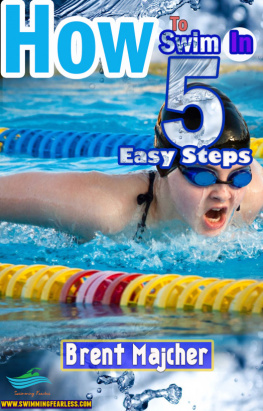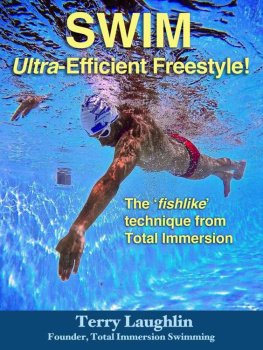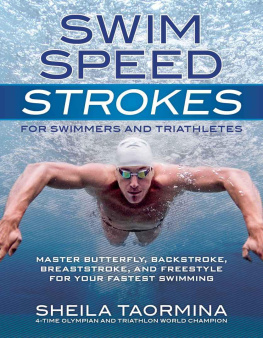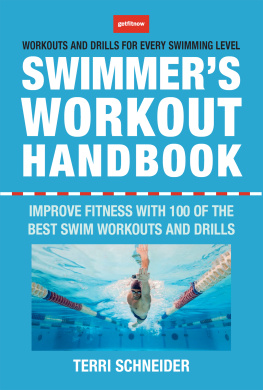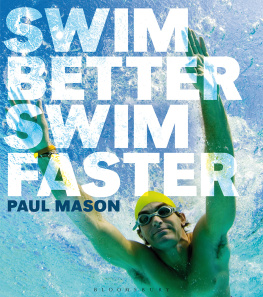How To Swim
Chase Watson
Copyright 2016 ChaseWatson
Distributed bySmashwords
Smashwords Edition, License Notes Thank you for downloading thisebook. This book remains the copyrighted property of the author,and may not be redistributed to others for commercial ornon-commercial purposes. If you enjoyed this book, please encourageyour friends to download their own copy from their favouriteauthorized retailer. Thank you for yoursupport.
Contents
Introduction
So you want tobe a better swimmer? You've gone out of your way to search theright information? You've gotten your hands on it. Now it's yourjob to consume it; digest it; let it become a part of you. You willbe amazed at the level of progress you will see in yourself in avery short space of time given you put into action every stepoutlined in this guide.
Find out thetechniques the professionals use to make them distinguishedswimmers in the pool and learn what tips will improve yourstrength, form and speed in the pool. Whatever level you're at, ifyou transfer the skills provided in this book into your swimming,one thing's for sure, when you enter the pool, you'll feel the wayOlympians feel; move the way champions move and swim the wayprofessionals swim. Now let's get into the pool!
Learning tofloat: The Swimmer's Technique
The inabilityto float has often been at the centre of all swimming difficultiesfor most inexperienced or untrained swimmers. Whether you are juststarting out or you know the pool well, the following tips will getyou headed steadily in the right direction.
Now, whateverthe reason may have been - you don't like the feeling ofweightlessness in the water creating the feeling that youresinking or, it's the thought of tipping over to your back thatscares you - without learning to float effortlessly you will notenjoy the discipline of swimming continuously.
Floating iswhat wed refer to as the foundation, the bricks and mortar of thestructure that we're building. Rest assured, the more time youspend perfecting this exercise - the quicker you determine yournext level.
First andforemost - floating on your front. Regarding your body position,your eyes and your head need to be pointing towards the bottom ofthe pool with your body stretched into a nice straight line at thewater's surface.
Sounds easydoesn't it? But this simple relaxed form is what a lot of swimmersstruggle with and therefore cannot progress to the more excitingstuff. So practise getting this right first.
Here's what youneed to know:
1) Get rid ofall the unnecessary movements
Start as youmean to go on. A great form right at the beginning encourages greatform throughout the swim. Just take a look at this approach.Imagine that you were standing on the end of a five metre divingboard and rather than jumping in yourself, you held out your handand dropped a tennis ball into the water. What would happen?
Chances aregravity is going to take its hold on the ball, cause it to hit thesurface of the pool where it will disappear under the surface for afew moments, then bob back up, then it will disappear under thesurface of the pool for a moment, this time a little less deep andthen bob back up again, and it might do this a few times beforesettling calmly at the top of the water where it at last floatseffortlessly.
Now imagine you practised the same exercise but this timenot from the edge of the five metre diving board but just from theside of the pool. You bend down, hold your arm out, and then gentlyplace the tennis ball onto the surface of the water. What willhappen this time round?
There will beno forceful entry into the water and the tennis ball would juststart floating right from when you place it in the water. Why didthe tennis ball react this way - because you were gentle and didnot allow for unnecessary movements.
A similar idearesonates when you attempt to float in the water. If you start toohigh the chances are that you're going to sink, and if you starttoo low (with your head beneath the water) chances are that you'regoing to sink. Now say this after me - 'I am not a tennis ball, butI float like a tennis ball', and as you say this - be sure tovisualize exactly what you are saying.
The next timeyou enter the pool to do this, bearing in mind that youre puttinginto action all that I've stated - you will float like a tennisball. Smiley face emoji.
So nexttime you get into the pool ...
a) Stand up inthe water
b) Squat down,(bend your knees so your shoulders are flush with the water) nowthis doesn't mean bend forward, just lower yourself into the water- the only thing sticking out of the water should be your head -your body still remains vertical only that it's lowered into thewater because of the squat/knee bend.
2) Start belowthe water
By the time youhave the first part done and you are nicely immersed up to yourneck in water - you're nicely positioned to get started. Anotherkey point to note - when first learning to float have your armsextended straight (bending of elbows won't help) this way you addmore weight to your upper body meaning your legs will find it mucheasier to float.
Now the keyhere is to stretch your arms out and relax them. Novices often getinto trouble here because as they extend their arms they do itrigidly which brings to mind the snowman with sticks as arms.
This isn't whatyou want as it often leads to the arms sticking out of the waterwhich means they're less likely to float. Create this picture inyour mind: there is a plank fifteen centimetres under the water andyou're going to use that plank as a support for your arms.
Relax them andrest them there as that's where they're going to stay as you float.It is also important to assert here that there should really be notime during this phase that your fingers or your hands break thesurface of the water as - yes you guessed it - you'll start sinkingagain.
3) FinalRecap
Lower yourselfinto the water by squatting, head above the water with shouldersbeneath the water, extend arms forward but in a relaxed state -allow for no tension whatsoever - just relax - the water is yourfriend not your enemy. Now all that is left is to take a deepbreath and put your head face down into the water - your eyesshould see the floor of the pool with you entire head below thewater.
Asaforementioned be careful to watch your arms that they do not breakthe surface of the water. This is often the crux that sees mostnovices struggling with their technique. The reality is this -whilst floating your body is never really in a true straight line -you are pushing your arms down into the water slightly as you floatto maintain the equilibrium that keeps you afloat.
Fancy practisingyour floating form without getting wet?
Get onto a parkbench and lie flat, face down with arms extending outwards, yourfingers/palms pointing towards the ground and your chin right atthe edge of the bench eyes looking down. This exercise will get youready for the real deal in the pool.
The Freestyle(also known as Front Crawl)
The freestyleis perhaps the earliest known stroke and the most popular one forswimmers all around the world.
Now very fewhave the ability to make the front crawl look like somethingstraight out of a Hollywood motion picture but here are few tipsthat will set you well on your way:
In thePool:
1) Aim to haveyour body in a flat (as flat as the body goes that is), streamlinedposition in the water with a slight slope about the hips to makeroom for the leg kick underwater.
2) Your stomachalso ought to be flat and level to bring support to your lowerback.
3) Now, eyeslooking down and forward, your head in line with the body. Thewater level should come between your eyebrows and yourhairline.




